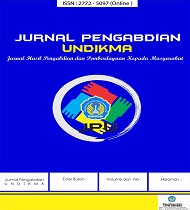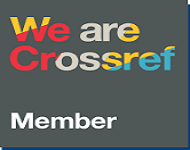Pengembangan Perangkat Pembelajaran Model Problem Based Learning Melalui Penggunaan Bahan Manipulatif
DOI:
https://doi.org/10.33394/jk.v6i3.2861Keywords:
Learning Kits, Problem Based Learning, Manipulative Materials.Abstract
References
Ajai, J.T., Imoko, B.I., & O’kwu, E.I. (2013). Comparison of the learning effectiveness of problem-based learning (PBL) and conventional method of teaching algebra. Journal of Eduaction and Practice, 4(1), 131-135.
Akbar, A. (2019). Implementasi Model Pembelajaran Berbasis Masalah untuk Meningkatkan Hasil Belajar Siswa pada Mata Pelajaran PKn di SMA Negeri 1 Batukliang Utara. Jurnal Kependidikan: Jurnal Hasil Penelitian dan Kajian Kepustakaan di Bidang Pendidikan, Pengajaran dan Pembelajaran, 5(1). doi https://doi.org/10.33394/jk.v5i1.1386
Arthur Y. D, Oduro, F. T & Boadi. R. K. (2014). Statistical analysis of ghanaian students attitude and interest towards learning mathematics. International Journal of Education and Research Vol. 2 No. 6 661-670
Astutik, H. (2017). Keefektifan pembelajaran berdasarkan masalah pada bangun ruang sisi datar ditinjau dari penguasaan SK, motivasi, dan minat siswa SMP. Jurnal Riset Pendidikan Matematika, 4(1), 56-66. doi:http://dx.doi.org/10.21831/jrpm.v4i1.12722
Bloom, B. S. et al. (1956). Taxonomy of Educational Objectives: Handbook 1, Cognitive Domain. New York: David McKay.
Brown, M. W. (2009). The teacher-tool relationship: theorizing the design and use of curriculum materials. Dalam Remillard, J. T., Eisenmann, B. A. h., & Lloyd, G. M. 2009. Mathematics teachers at work connecting curriculum materials and classroom instruction. New York, NY: Routledge.
Cockett, A. & Kilgour, P. W. (2015) "Mathematical Manipulatives: Creating an Environment for Understanding, Efficiency, Engagement, and Enjoyment," Teach Collection of Christian Education. 11 (5). Available at: http://research.avondale.edu.au/teachcollection/vol1/iss1/5
Cope, L. (2015). Math manipulatives: making the abstract tangible. Delta Journal of Education. 5(1), 10-19
Depdikbud. (2016). Peraturan Menteri Pendidikan dan Kebudayaan Nasional Republik Indonesia tentang Standar Isi untuk Satuan Pendidikan Dasar dan Menengah. Jakarta: Depdiknas.
Depdikbud. (2013). Peraturan Menteri Pendidikan dan Kebudayaan Republik Indonesia tentang Standar Proses Pendidikan Dasar dan Menengah. Jakarta: Depdiknas.
Elizabeth, A., & Sigahitong, M., M. (2018). Pengaruh Model Problem Based Learning Terhadap Kemampuan Berpikir Kreatif Peserta Didik SMA. Prisma Sains: Jurnal Pengkajian Ilmu dan Pembelajaran Matematika dan IPA IKIP Mataram, 6(2), 67-76. doi: https://doi.org/10.33394/j-ps.v6i2.1044
Enki, K. (2014). Effects of using manipulatives on seventh grade students’ achievement in transformation geometry and orthogonal views of geometric figures. Unpublished master’s thesis. Ankara: Middle East Technical University .
Essien, E. E., Akpan, O. E., & Obot, I. M. (2015). Students’ interest in social studies and academic achievement in tertiary institutions in cross river state, Nigeria. European Journal of Training and Development Studies, 2,(2), 35-40.
Fennema, E., & Romberg, T. A. (Eds). (1999). Mathematics classrooms that promote understanding. New Jersey: Lawrence Erlbaum Associates, Inc.
Herisnawati., Nurhidayati, S., & Wijayanti, T.S. (2015). Pengaruh Metode Make A Match Terhadap Aktivitas, Minat dan Hasil Belajar Siswa pada Pembelajaran IPA. Prisma Sains: Jurnal Pengkajian Ilmu dan Pembelajaran Matematika dan IPA IKIP Mataram, 3(2), 93-101. doi: https://doi.org/10.33394/j-ps.v3i2.975
Hasanah, U., Gummah, S., Herayanti, L. (2018). Pengaruh Penggunaan Handout Berbasis Pemecahan Masalah Terhadap Keterampilan Berpikir Kritis Dan Keterampilan Berpikir Kreatif Siswa. Prisma Sains: Jurnal Pengkajian Ilmu dan Pembelajaran Matematika dan IPA IKIP Mataram, 6(1), 38-45.
Hosnan, M. (2014). Pendekatan saintifik dan kontekstual dalam pembelajaran abad 21. Bogor: Ghalia Indonesia.
Jiniarti1, B. E., Sahidu, H. & Verawati, N. N. S. P. (2015). . Implementasi Model Problem Based Learning Berbantuan Alat Peraga untuk Meningkatkan Aktivitas dan Hasil Belajar Fisika Siswa Kelas VIII SMPN 22 Mataram. Prima Sains: Jurnal Pengkajian Ilmu dan Pembelajaran Matematika dan IPA. 3(1), p.27-33. doi:https://doi.org/10.33394/j-ps.v3i1.1075
Kontas, H. (2016). The effect of manipulatives on mathematics achievement and attitudes of secondary school students. Journal of Education and Learning, 5, (3), p 10-20
Koroh, T., & Ly, P. (2020). Pengaruh Model Pembelajaran Problem Based Learning dalam Pembelajaran Pendidikan Kewarganegaraan terhadap Kemampuan Berpikir Kritis Mahasiswa. Jurnal Kependidikan: Jurnal Hasil Penelitian dan Kajian Kepustakaan di Bidang Pendidikan, Pengajaran dan Pembelajaran, 6(1). doi: https://doi.org/10.33394/jk.v6i1.2445
Mashuri, S., Djidu, H., & Ningrum, R. K. (2019). Problem-based learning dalam pembelajaran matematika: Upaya guru untuk meningkatkan minat dan prestasi belajar siswa. PYTHAGORAS: Jurnal Pendidikan Matematika, 14(2), 112-125. doi: https://doi.org/10.21831/pg.v14i2.25034
McArdle, G. (2010). Instructional design for action learning. New York: NY: Amacom.
Meke, K.D.P et al (2018). The Effectiveness of Problem-based Learning Using Manipulative Materials Approach on Cognitive Ability in Mathematics Learning. J. Phys.: Conf. Ser. 1097 (012135). 1-7
Meke, K.D.P, Jailani, J., Wutsqa, D.U. & Alfi, F.D. (2019). Problem based learning using manipulative materials to improve student interest of mathematics learning. J. Phys.: Conf. Ser. 1157 (032099),1-8.
Meke, K.D.P., Wondo, M.T.S., & Wutsqa, D.U. (2020). Pembelajaran Problem Based Learning dengan Penggunaan Bahan Manipulatif Ditinjau dari Minat Belajar Matematika. JPPM: Jurnal Penelitian dan Pembelajaran Matematika. 13(2), 164-177
Nitko, A. J., & Brookhart S. M. (2011). Educational Assessment of Students (6th ed). Boston, MA: Pearson Education, Inc.
Pantziara, M. & Philippou, G. N. (2014). Students’ motivation in the mathematics classroom. Revealing causes and consequences. International Journal of Science and Mathematics Education, 13(2), 385-411
Plomp. T. (2013). Educational design research: an introduction. Dalam Plomp, T & Nieveen, N. (eds), Educational design research part A: an introduction. Enschede: SLO.
Prayogi, S. & Asy’ari. M. (2013). Implementasi Model PBL (Problem Based Learning) untuk Meningkatkan Hasil Belajar dan Kemampuan Berpikir Kritis Siswa. Prima Sains: Jurnal Pengkajian Ilmu dan Pembelajaran Matematika dan IPA. 1(1). p.80-88.
Rahmawati, U., & Suryanto, S. (2014). Pengembangan model pembelajaran matematika berbasis masalah untuk siswa SMP. Jurnal Riset Pendidikan Matematika, 1(1), 88-97.
Reys, R. E., Syudam, M. N., Linquist, M. M., & Smith, N. L. (1998). Helping children learn mathematics (5th ed). Needham Heights, MA: Allyn & Bacon.
Sasongko, H.W. & Jailani, (2014) Tinjauan keefektifan group investigation menggunakan alat peraga manipulatif dari aspek prestasi belajar bangun ruang sisi datar dan apresiasi terhadap matematika SMP. Pythagoras: Jurnal Pendidikan Matematika. 9(2). 136-146
Schukajlow, et. al (2012). Teaching methods for modelling problems and students’ task-specific enjoyment, value, interest and self-efficacy expectations. Educ Stud Math, 79, 215–237.
Sulistyani, N., & Retnawati, H. (2015). Pengembangan perangkat pembelajaran bangun ruang di SMP dengan pendekatan problem-based learning. Jurnal Riset Pendidikan Matematika, 2(2), 197 - 210.
Susanto, E., & Retnawati, H. (2016). Perangkat pembelajaran matematika bercirikan PBL untuk mengembangkan HOTS siswa SMA. Jurnal Riset Pendidikan Matematika, 3(2), 189-197. doi:http://dx.doi.org/10.21831/jrpm.v3i2.10631
Trianto. (2012). Model pembelajaran terpadu: Konsep, strategi, dan implementasi dalam KTSP. Jakarta: Prestasi Pustaka Publisher.
Wondo, M. (2017). Pengembangan perangkat pembelajaran matematika SMP kelas VIII semester genap dengan model problem-based learning. PYTHAGORAS: Jurnal Pendidikan Matematika, 12(1), 76-86. doi:http://dx.doi.org/10.21831/pg.v12i1.14056
Yulistiyarini, H & Mahmudi, A. (2015). Pengembangan perangkat pembelajaran materi geometri ruang SMP dengan memanfaatkan alat peraga manipulatif dan lingkungan. Pythagoras: Jurnal Pendidikan Matematika. 10 (2), 155-167.
Downloads
Published
How to Cite
Issue
Section
Citation Check
License
License and Publishing Agreement
In submitting the manuscript to the journal, the authors certify that:
- They are authorized by their co-authors to enter into these arrangements.
- The work described has not been formally published before, except in the form of an abstract or as part of a published lecture, review, thesis, or overlay journal.
- That it is not under consideration for publication elsewhere,
- That its publication has been approved by all the author(s) and by the responsible authorities tacitly or explicitly of the institutes where the work has been carried out.
- They secure the right to reproduce any material that has already been published or copyrighted elsewhere.
- They agree to the following license and publishing agreement.
Copyright
Authors who publish with JK agree to the following terms:
- Authors retain copyright and grant the journal right of first publication with the work simultaneously licensed under a Creative Commons Attribution License (CC BY-SA 4.0) that allows others to share the work with an acknowledgment of the work's authorship and initial publication in this journal.
- Authors are able to enter into separate, additional contractual arrangements for the non-exclusive distribution of the journal's published version of the work (e.g., post it to an institutional repository or publish it in a book), with an acknowledgment of its initial publication in this journal.
- Authors are permitted and encouraged to post their work online (e.g., in institutional repositories or on their website) prior to and during the submission process, as it can lead to productive exchanges, as well as earlier and greater citation of published work.
Licensing for Data Publication
-
Open Data Commons Attribution License, http://www.opendatacommons.org/licenses/by/1.0/ (default)

This work is licensed under a Creative Commons Attribution-ShareAlike 4.0 International License.







